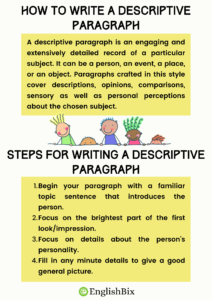A descriptive paragraph is an engaging and extensively detailed record of a particular subject. It can be a person, an event, a place, or an object. Paragraphs crafted in this style cover descriptions, opinions, comparisons, sensory as well as personal perceptions about the chosen subject.
While weaving a descriptive paragraph use words that allow your reader to see what you are describing without actually being able to see it. To put it aptly you have to mentally teleport him to that world with your words. To do so, strong action words with interesting adjectives should be used.
It should pass on that feeling or memory to the reader. These paragraphs help the reader feel as well as sense the subtleties through the writer’s lens.
Before settling down to craft a descriptive paragraph you should contemplate your subject keenly, and jot down the subtleties you encounter. Then you should arrange these subtleties appealingly and intelligently.
To crack open the best results, descriptive writing should be concrete, arousing, and accessible.
- To ensure concreteness, descriptive writing should provide details that the reader can feel and see.
- To convey an impression, descriptive writing should include a concrete and vivid image that helps the reader look at the picture just as the writer wants him to.
- Convincingly, the descriptive writer should be able to match the reader’s knowledge and attention by pressing the provocative image.
Descriptive writing holds a unique and appealing power. It lets the reader touch, see, taste, hear and even smell what the writer is describing. It won’t be wrong to say that descriptive details give life to the writing.
Examples of Descriptive Paragraphs
Let’s have a look at some examples of descriptive texts to understand the concept in great detail. Shall we? Here we go!
Example 1:
My family and friends ate dinner at a local restaurant every Saturday night when I was younger. We approached a large purple booth as we read the familiar menu. The sweet smell of vanilla sat in the air. I held my mother’s hand as she ordered our drinks.
The waiter offered us our thick milk and placed it in front of us on a comfortable piece of tissue. The jug box on the back played songs at full blast that we all sang until our food arrived, hot and enticing on the table. Outside I was shivering in the biting air, but at the restaurant, I was warm and comfortable. Cooking french fries and enjoying a hot and mouth-watering cheeseburger.
(With this example, we sense the feelings described by the author. Using the magic of words the author strives to convey a sense of security, comfort, and happiness. Did you notice how the author does not tell the reader that he feels safe and happy? The writer forges a connection with the reader by describing his outstanding vision of comfort and happiness.)
Example 2:
My father and I walked along a boardwalk every afternoon to experience the vastness of the sea. We listened to the waves as we approached closer. We usually stopped for snacks at our favorite boardwalk shop. After that, we continued our journey along the beach and let the water wet our feet.
(This example beautifully describes how to use the power of senses: sight, sound, smell, taste, and touch.)
How to Write an Effective Descriptive paragraph
There are some pro tips that you can use to pen down an effective descriptive paragraph. Proper structuring and usage of unfamiliar and sharp phrases help grab your reader’s attention. When you are describing someone or something, your words should make the reader feel your emotion. As if they are physically present there to witness what’s happening.
- Begin your paragraph with a familiar topic sentence that introduces the person. Starting off the paragraph with a short introductory sentence will help summon the reader’s attention. At the same time, this will help direct their focus to the person you are going to describe. This paragraph should be based on the principles of conciseness and clarity focusing on one aspect of appearance. The point behind this is to not overwhelm the reader with too much meaning.
- Focus on the brightest part of the first look/impression. To grasp and retain the attention of your reader, start with a general sentence and then gradually move towards specificity. It will spark a feeling of connection by starting a virtual picture in the reader’s head as if he’s beginning to see it.
- Focus on details about the person’s personality. Being meticulous while choosing descriptive words is the key to acing the game. Doing so offers a vivid picture of the person while offering the reader a good idea of who that person is.
- Fill in any minute details to give a good general picture. Ensure that your reader has a good idea of the most important parts of this person’s appearance. Describe everything that is a part of his identity. From his face, his important body parts to his clothes. Since these are the parts that fascinate the reader and make him crave for more.
You can download the following image to quickly revise what we have just understood about the descriptive paragraphs.

Quick Links

